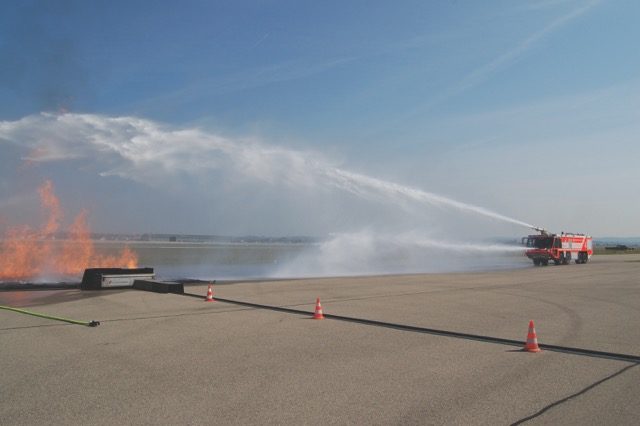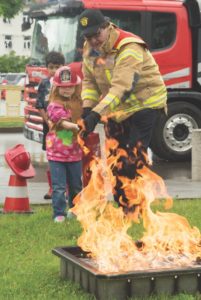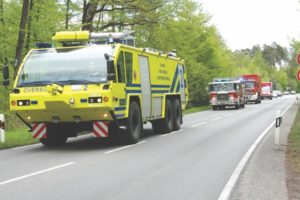
By John Reese
USAG Stuttgart Public Affairs
A famous old story placed the cause of the Great Chicago Fire of Oct. 8-10, 1871 to a cow kicking over a lantern while being milked. While that version of events has been debunked and other theories for the start of that great conflagration are still argued 146 years later, the fire has become a teaching moment every October with National Fire Prevention Week observed in the U.S. and Canada.
The annual week of fire prevention awareness, centered on Oct. 9, has been around since a 1925 presidential proclamation. It is now a public a become a time to remind people about the need for
A combination of fire prevention awareness, improved firefighting equipment and tactics, and better building codes and other regulations since 1980 has paid off. The total number of all fires reported in the U.S. dropped by 1,642,500 by 2015, according to statistics provided by the National Fire Protection Association.

The U.S. Army Garrison-Stuttgart Fire Department responds to about 375 fire-related calls per year. The 40-member department, including the chief, assistant chief, inspectors, firefighters and admin support personnel, respond to calls on the garrison’s five installations, supported as necessary by hundreds of firefighters serving at civilian fire departments in the surrounding communities; for example, the City of Stuttgart Fire Department took part in the force protection exercise on Patch Barracks, Sept. 16.
“There are procedures in place for mutual aid with the local fire departments, such as mutual support for structural fires,” said Chief Karl J. Dörsam. “For Robinson Barracks, we rely completely on Stuttgart city for support. In regards to medical emergencies, we rely on host nation ambulances in every situation.”
Causes of fires
Structure fires are the leading type of fires, followed by brush fires, highway vehicles and rubbish (including dumpster) fires. Home fires account for the “majority of Kitchen fires from unattended cooking continue to be a problem, explained Asst. Chief Leonard Fagan, USAG Stuttgart FD.
“Unattended cooking fires are still the biggest cause of domestic fires.” Fagan said, adding that the garrison followed the trend in America with reduced fires because of education. Unattended cooking fires used to be that the primary fire cause for residential fires in Stuttgart, as in America. “Every fire safety class I give starts with the same slides, I preach the same thing “If you are not there it is unattended cooking.”
Fire departments respond to far more calls unrelated to fires. In fact, the NFPA reported that in “2015, only 4 percent of all fire department responses were to fires.” Additionally, “despite the decline in reported fires, fire department responses have nearly tripled from 11,888,000 total incidents in 1985 to 33, 602,500 in 2015.”

“We receive about 750 calls a year; between 10 and 20 average the last couple of years are for real fires, from smoldering popcorn to dumpster fires to vehicles,” said Dörsam.
The number of responses by the garrison fire department has tripled over the last 20 years, but so has the level of security, Fagan said. Across the garrison, there are more than 25,000 smoke detection devices. The increase in the number of devices has caused an increase in the number of potential unwanted alarms. The false alarm rate was lowered by issuing “hot work permits” to contractors doing cutting, grinding or welding.
“Twenty years ago, we did not have as many fire alarm systems and automatic smoke detection devices, like smoke alarms,” Fagan said. “Since Jan. 1, 2015, there is a requirement for all sleeping rooms and means of egress in all homes in Baden-Württemberg.”
Fire safety at home begins with awareness of potential hazards. Whether a community member lives on or off post, many of the basics apply, such as escape planning, washer and dryer fires due to a failure to clean them, medical oxygen and the use of gasoline and propane at home. A pause had to be called during the Sept. 16 exercise that was related to a camping-sized propane bottle. Fortunately, the call turned out to be preventative and extremely minor, as are many calls received by fire departments on a daily basis; think about the cat-stuck-in-a tree scenario.

“We are constantly interacting with the community, especially with the children,” Fagan said. Children at school or day care are involved in monthly fire drill to ensure that if something happens, they or their caregiver knows what to do. “Through these fire drills we become involved in the lives of thousands of kids every month.”
For the USAG Stuttgart Fire Department, fire prevention is 52 weeks per year, not just one. The firefighters have to be ready, 24/7, year-round, for anything.
